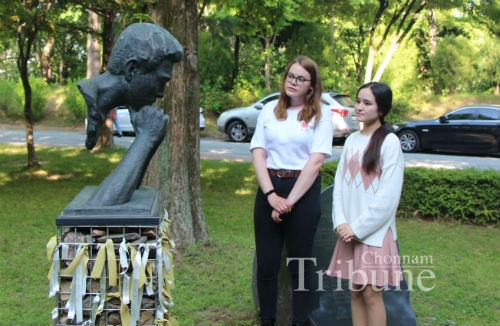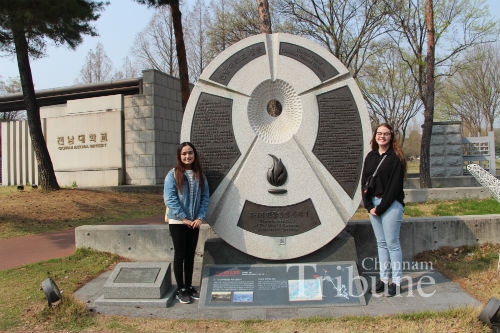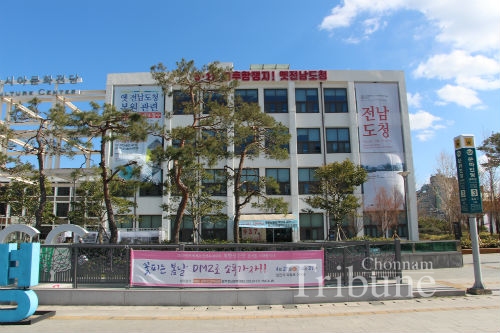
Known as family month in Korea, May has significant and unforgettable meanings for Gwangju citizens and especially students of Chonnam National University (CNU). 39 years ago, the May 18 Democratic Uprising started at the main gate of CNU to protect Korea’s democracy. It showed Korean’s - especially, Gwangju citizens’- desire for democracy and also Gwangju’s high level of community spirit. At that time, CNU students including Martyr Yun Sang-won was a spokesperson for the Gwangju citizen army fight for democracy and sacrificed himself during the uprising. The Chonnam Tribune selected some historic sites related to the uprising and took a road trip to the memorial spots on the May 18 Road with international students who are attending CNU. Walking the road trail made foreign and local students learn the historic significances and feel the spirit of May 18 on the streets
The Starting Point of the Uprising
In early April, Tribune reporters and two international students gathered before CNU’s main gate. It is the first historical site as the starting point of MDU. In the spring of 1980, Korea was overwhelmed with hopes of democracy starting with university students’ protesting for democratization all over the country. However, on May 17, 1980, an emergency martial law was declared to stop the nationwide democratization movement, and airborne troops were sent to Gwangju. At about 10 a.m. the next day, around 200 CNU students and the troops had the first collision in front of the gate. The troops cruelly beat and illegally detained demilitarized students at random just like they were on a mission to kill innocent people. This made Gwangju citizens outraged and they gathered outside to protest.
Molly Mckee (Exchange Student, Dept. of English Language and Literature) from the U.S. said, “The students and civilians that were involved in the Uprising were incredibly brave. Their decision to come together and fight for democracy, what they believe in - along with their determination, passion, and refusal to give up - is incredibly inspiring. From my understanding, the result was tragic because of the brutal repression by the government but the movement still played a vital role for Korea’s democracy. I feel proud to study at this university and live in this city, after I listened to the explanations of the uprising.”

The Last Bastion of the Uprising
Our next destination was the former Jeonnam Provincial Government building. It looks comparatively cold and sad since it kept the pain of May 18. At the entrance, Madinakhon Nazarova (Sophomore, Faculty of Business Administration) from Uzbekistan said, “I really wanted to come and see this place because l learned about the May 18 Democratization Movement from my professor. By visiting here, I could get lots more detailed information about it.”
This building was where the official leadership of the uprising was held. It was also the place where the beginning and end of the militia’s struggle in Gwangju was announced. The uprising headquarters were located in this building and so were committees of citizens and students that led activities for Gwangju citizens. For three days prior to May 18, students and citizens gathered there and announced the declaration, calling for the end of military rule and democratization. It was also the last resistance place for the citizen militia that fought against the military repression of the martial law forces on May 27, and many members of the militia died in the last resistance.
Looking around the exhibits in the building, Molly mentioned, “Visiting this place made my heart a bit heavy. Walking through a structure that once served as a refuge was a very strange feeling. The people who took shelter there felt a hundred different emotions, and even though I visited a few decades later, I almost felt like I was intruding.”

The Memory of the Past
We started to walk along Geumnam-ro which is the fourth historical site that symbolizes the May 18 Democratization Movement. Hundreds of thousands of outraged citizens gathered daily to urge democratization against the martial law. The troops were to blame for a mass shooting that occurred, they aimed at innocent citizens indiscriminately for ten minutes on May 21. Located next to a large public square in front of the former Jeonnam Provincial Government building, Jeonil Building was left with 245 bullet holes. Looking at the bullet marks on the building, Molly said, “I immediately wondered how the government thought it could get away with denying violence on their end. Seeing the marks made me relate with the citizens' outrage at the time.”
Walking along the street, we moved toward the 5·18 Archives building which opened in 2015. The archives were founded to preserve and exhibit the historic records of the uprising, including nine memorial materials registered as UNESCO’s Memory of the World in 2011. There were also various things that show what the situation was like in those days and the passion of Gwangju citizens to keep democracy in Korea. The records show people from around the world how important these events were.
The international students chose the 5·18 Archives as the best place among all the spots they visited during this May Road trip. Madinakhon said, “The best place for me during the trip was the Archives because l witnessed with my own eyes some materials related to the May 18 Movement. It was so impressive to see them, and they made us imagine the situation in Gwangju at that time.” Molly said, “I liked visiting the archives the most. Being able to see actual letters that were written at the time of the movement, along with footage from the movement itself, helped me feel more connected with the history.”
The Community Spirit of Gwangju
In the archives, there was the hallway that represents what the street looked like in those days. Under the glass along the hallway, many things such as shoes, papers or clothes looked so real and showed the reality of those days. Molly added, “It made the experience feel like more than just walking through a museum. Also, the projection that showed the identities of the lives that were lost during the movement gave me a different perspective; looking past the collective and paying attention to individuals hit me pretty hard.”
There was also a big metal bucket that used to contain rice balls for student and citizen protesters. Women and storekeepers in Daein and Yangdong traditional markets began to make rice balls. They voluntarily raised money to distribute bread, milk and rice balls to demonstrators. They took the lead with their community spirit by making and sharing rice balls, carrying water in a bucket, giving it to thirsty people, and participating in demonstrations together. It showed the spirit of “daedong” (great unity), that is, the community spirit of Gwangju. Thus, we moved to Yangdong market to see with our eyes how it is now. The market is the 19th historical site and was full of delicious foods, good products and people. People making rice balls then are no longer there, but the community spirit of Gwangju in 1980 still remains.

The Legacy of the May 18 Uprising
This year marks the 39th anniversary of the May 18 Democratization Movement. It has been recognized worldwide for providing a valuable experience for the people in foreign countries such as the Philippines, Thailand, Indonesia, China and Vietnam to fight against their dictatorship regimes, and at the same time serves as a mental indicator for the democratization movement.
With regard to its impact on Asian nations, Choi Jeong-gi, Director of the May 18 Institute at CNU commented, “The process of the May 18 Democratization Movement is a process of building human rights and democracy from a totalitarian and authoritarian regime. It is also an effort to lay the foundations for justice and peace through such a process. The May 18 Uprising presented a model for other countries in Asia. Clean-up work which has achieved rapid results and the effort to establish transition have also become a great precedent for other countries.”
As the glorious symbol for democracy of Korea, the movement has influenced not only Korea’s democracy but also that of other countries globally as well. From this point of view, walking the May 18 Road with international students would be a good chance to share the spirit of Gwangju.
By Park Seon-ah, Student Editor

